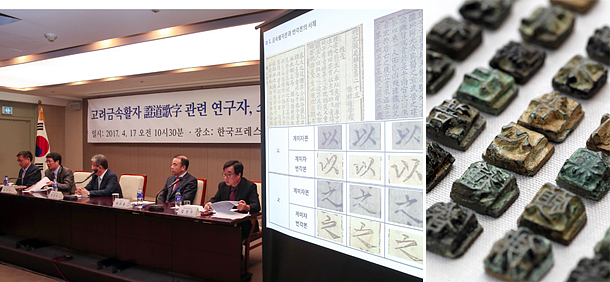Owner of old type slams the CHA

The owner of the movable metal type supposedly from the 13th century (right) and some researchers refute the government’s recent conclusion that the type is not what they claimed it to be. [YONHAP]
Kim Jong-chun, chairman of the Korean Antiques Association and director of the Daboseong Ancient Art Museum, has claimed he owns 101 pieces of movable metal type used to print the Jengdoga in the early 1200s, about 130 years before “Jikji Simche Yojeol” (1377), the book historians believe to be the first known use of movable metal type.
Jeungdoga’s actual name is “Nammyeong Cheon Hwasangsong Jeungdoga (Song of Enlightenment with Commentaries by Buddhist Monk Nammyeong).” A version of the book printed with woodblocks was made in 1239. But historical records say the book was first printed using movable metal type. Neither a copy of that book or the movable type have been found.
The state-run Cultural Heritage Administration concluded its examination into Kim’s type and said the typefaces and castings on Kim’s type was not used to print the Jeungdoga. It left open the possibility that the type could be from Korea’s Goryeo Dynasty (918-1392), which in itself is quite a discovery as currently no verified movable metal type from the Goryeo period exist.
“It was CHA that convinced me to apply for [the type] to become a state treasure in 2011,” Kim argued in a press conference yesterday. “I highly doubt that the CHA conducted the review appropriately over all these years.”
Kim even alleged that in the process, the CHA damaged five of his pieces of movable metal type and there were threats made, raising the possibility of a conspiracy.
“There is a group of people who threatened to put the director of the CHA in court if the type became a national treasure,” Kim said. “We should investigate this and get to the bottom of what happened.”
Nam Kwon-hee, professor of library and information science at Kyungpook National University, and Yu Bu-hyeon, professor of library and information science at Daejin University, were among those present at the press conference agreeing with Kim.
They argued that the CHA allegation that the typeface on the type and on the book (printed on woodblocks) differ lacked credibility.
Nam and Yu said the version printed with woodblocks would necessarily be very different from the version printed with movable metal type.
The CHA also said last week that how Kim came into possession of the type wasn’t clear, another reason it was not able to recognize the artifacts as a treasure. “Do all cultural heritage items that are designated [as national treasure] have transparent sources?” Kim asked.
Kim’s reputation has been challenged several times in recent years, as he was sued for fraud, illegal trading and false appraisal, some of which he was cleared of.
Another point of contention are the close ties between Kim, Professor Nam and the Cheongju Early Printing Museum - another organization that claims to have pieces of Jeungdogaja. It was Nam and his colleagues that purchased the seven pieces of type now in the museum’s collection for 86.3 million won ($74,600) with money provided by the Cheongju city government.
BY KIM HYUNG-EUN [hkim@joongang.co.kr]










with the Korea JoongAng Daily
To write comments, please log in to one of the accounts.
Standards Board Policy (0/250자)